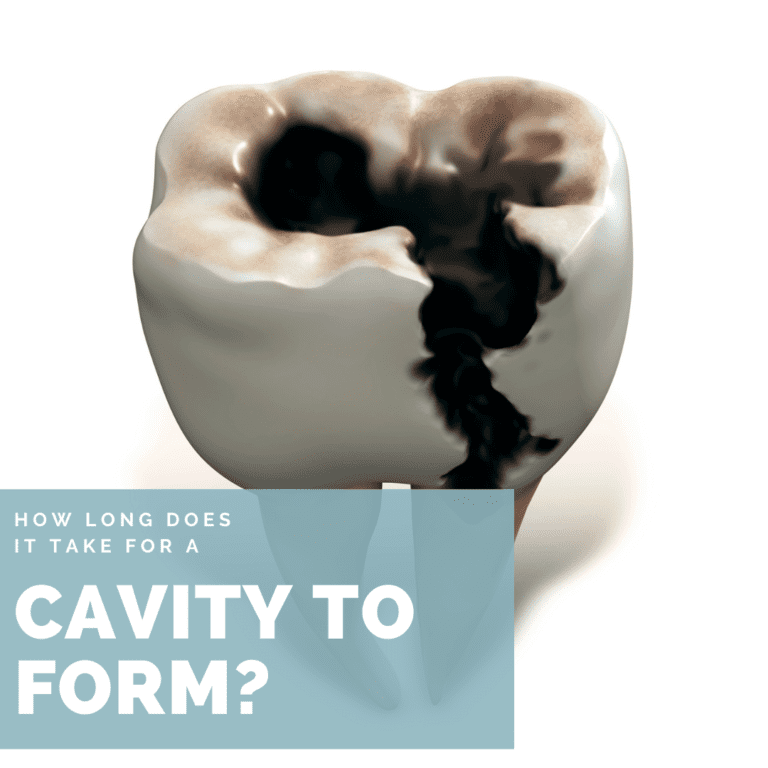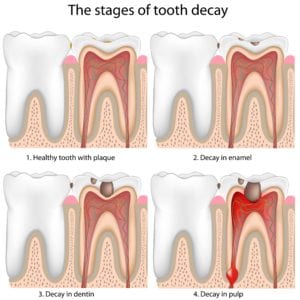How Long Does it Take for a Cavity to Form?

Cavities are one of the most prevalent health conditions. In fact, they are only second to the common cold. Not only are they extremely common, but severe cavities are one common reason for tooth loss or the need for extraction. However, teeth don’t go from being fine to needing to be extracted overnight. This raises the question of how long it takes a cavity to form and at what point it can pose the threat of tooth loss. Since there is no standard answer for how long it takes a cavity to form, we must look deeper at what cavities are and how they form in order to understand more about how quickly or slowly they can develop.

For starters, we need to have a firm understanding of what cavities are and what causes them. Cavities are holes in the teeth formed from acids that are released from bacteria found in dental plaque. Plaque is a sticky, clear film that sits on the surface of your teeth. Not only does plaque house thousands of bacteria, but it also catches food particles when you eat. This allows the bacteria to feed on the sugars and starches, converting them into an acidic waste product that is deposited onto the tooth surface. Over time as more and more acidic is deposited in one spot, the enamel eventually wears down and a cavity begins to form.
Cavities can form anywhere on the tooth surface and are named based on where they appear. For example, one common type of cavity is known as a pit and fissure cavity. These cavities are found in the pits and fissures that make up the chewing surface of the molars and premolars. This type of cavity is especially common since it is so easy for plaque to develop and remain undisturbed. Other locations cavities can form include the roots and on smooth surfaces. Generally speaking, root cavities only form when gum recession has exposed the tooth roots, which have a very thin layer of protective enamel. Smooth-surface cavities are less common since it is harder for plaque to accumulate on smooth surfaces.
Even though cavities can affect different parts of the tooth, the way that they develop is the same no matter where they form. There are five stages of tooth decay, including:

Stage 1: Demineralization
Demineralization occurs when the acids from bacteria cause the enamel to lose minerals. Since the mineral composition of enamel is the primary reason for its strength, losing minerals weakens the enamel. Since demineralization can be seen as white spots of the teeth, it may be able to be caught early and reversed with fluoride treatments.
Stage 2: Enamel Decay
After the enamel has been weakened, then the acids will start to erode through it. This forms a small to medium cavity that only affects the enamel. Cavities that only affect the enamel layer can usually be treated by placing a composite filling.
Stage 3: Dentin Decay
Directly below the enamel lies the dentin layer. If the acid continues to erode through the enamel, it will eventually reach the dentin. At this point, the cavity tends to grow in size. Therefore, cavities that affect the dentin layer usually need to be treated with larger fillings like inlays or onlays.
Stage 4: Pulp Decay
Below the dentin lies the innermost layer of the tooth known as the dental pulp. If the bacteria reaches the pulp layer, it will infect the inside of the tooth. Since the pulp is composed of blood vessels and nerves, a pulp infection will cause significant discomfort and pain. At this point, the only way to save the tooth is to perform a root canal to remove the infection.
Stage 5: Abscess
In some cases, a pulp infection can continue to spread deeper into the tooth, moving from the pulp chamber into the tooth roots through the root canals. This usually results in an abscess that forms at the base of the tooth roots. Not only is this extremely painful, but it usually results in the tooth being extracted.
How fast or slow a cavity goes from stage 1 to stage 5 depends on a number of factors. For starters, it is important to mention that not all cavities reach stage 5, and it is recommended to seek treatment early on to prevent the cavity from progressing. Since most cavities take years to form, seeing your dentist twice a year for regular dental checkups can save you from a stage 5 cavity. In fact, dentists can detect cavities in their earliest stages and provide the necessary treatment to prevent them from progressing.
Some factors that determine how fast or slow a cavity develops include:
- Location: cavities located in areas with more plaque accumulation tend to grow faster, while cavities located with less plaque tend to grow slower
- Diet: regularly consuming large amounts of sugar feeds the bacteria responsible for cavities, making them grow faster
- Oral hygiene: brushing twice a day, flossing daily, and regular dental cleanings helps to reduce the amount of plaque, which slows the growth of cavities






Recent Comments